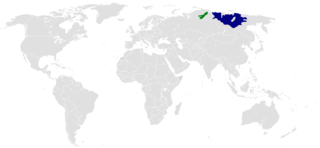In grammar, the comitative case is a grammatical case that denotes accompaniment. In English, the preposition "with", in the sense of "in company with" or "together with", plays a substantially similar role.
In grammar, the instrumental case is a grammatical case used to indicate that a noun is the instrument or means by or with which the subject achieves or accomplishes an action. The noun may be either a physical object or an abstract concept.

Southern or South Sámi is the southwesternmost of the Sámi languages, and is spoken in Norway and Sweden. It is an endangered language; the strongholds of this language are the municipalities of Snåsa, Røyrvik, Røros and Hattfjelldal in Norway. Of the approximately 2000 Southern Sami, only about 500 still speak fluent Southern Sami. This language belongs to the Saamic group within the Uralic language family.
In grammar, the sociative case is a grammatical case in the Hungarian, Tamil, and Malayalam languages that can express the person in whose company an action is carried out, or to any belongings of people which take part in an action.

Alyutor or Alutor is a language of Russia that belongs to the Chukotkan branch of the Chukotko-Kamchatkan languages.
The Elgeyo language, or Kalenjin proper, are a dialect cluster of the Kalenjin branch of the Nilotic language family.
Wintu is a Wintu language which was spoken by the Wintu people of Northern California. It was the northernmost member of the Wintun family of languages. The Wintun family of languages was spoken in the Shasta County, Trinity County, Sacramento River Valley and in adjacent areas up to the Carquinez Strait of San Francisco Bay. Wintun is a branch of the hypothetical Penutian language phylum or stock of languages of western North America, more closely related to four other families of Penutian languages spoken in California: Maiduan, Miwokan, Yokuts, and Costanoan.
Yakkha is a language spoken in parts of Nepal, Darjeeling district and Sikkim. The Yakkha-speaking villages are located to the East of the Arun river, in the southern part of the Sankhuwasabha district and in the northern part of the Dhankuta district of Nepal. About 14,000 people still speak the language, out of 17,003 ethnic Yakkha in Nepal. Genealogically, Yakkha belongs to the Eastern Kiranti languages and is in one subgroup with several Limbu languages, e.g. Belhare, Athpare, Chintang and Chulung. Ethnically however, the Yakkha people perceive themselves as distinct from the other Kiranti groups such as Limbu.

Kashaya is the critically endangered language of the Kashia band of the Pomo people. The Pomoan languages have been classified as part of the Hokan language family. The name Kashaya corresponds to words in neighboring languages with meanings such as "skillful" and "expert gambler". It is spoken by the Kashia Band of Pomo Indians of the Stewarts Point Rancheria.
Tariana is an endangered Maipurean language spoken along the Vaupés River in Amazonas, Brazil by approximately 100 people. Another approximately 1,500 people in the upper and middle Vaupés River area identify themselves as ethnic Tariana but do not speak the language fluently.
Nakanai is spoken by the Nakanai tribe in West New Britain, a province of Papua New Guinea. It is an Austronesian language, belonging to the Malayo-Polynesian subgroup. Otherwise known as Nakonai, it also has dialects in the form of Losa, Bileki, Vere, Ubae, and Maututu.
Maricopa or Piipaash is spoken by the Native American Maricopa people on two reservations in Arizona: the Salt River Pima-Maricopa Indian Community and the Gila River Indian Community. Most speakers live in Maricopa Colony. The language is considered severely endangered by UNESCO.

Aguaruna is an indigenous American language of the Chicham family spoken by the Aguaruna people in Northern Peru. According to Ethnologue, based on the 2007 Census, 53,400 people out of the 55,700 ethnic group speak Aguaruna, making up almost the entire population. It is used vigorously in all domains of life, both written and oral. It is written with the Latin script. The literacy rate in Aguaruna is 60-90%. However, there are few monolingual speakers today; nearly all speakers also speak Spanish. The school system begins with Aguaruna, and as the students progress, Spanish is gradually added. There is a positive outlook and connotation in regard to bilingualism. 50 to 75% of the Aguaruna population are literate in Spanish. A modest dictionary of the language has been published.
The associative case is a grammatical case which expresses associativity which is, although related, not identical to comitativity, which is expressed by using the comitative case.

Yakut, also known as Yakutian, Sakha, Saqa or Saxa, is a Turkic language belonging to Siberian Turkic branch and spoken by around 450,000 native speakers, primarily the ethnic Yakuts and one of the official languages of Sakha (Yakutia), a federal republic in the Russian Federation.
In linguistics, the ornative case is a noun case that means "endowed with" or "supplied with".
Panará, also known as Kreen Akarore, is a Jê language spoken by the Panará people of Mato Grosso, Brazil. It is a direct descendant of Southern Kayapó. Although classified as a Northern Jê language in earlier scholarship, Panará differs considerably from the Northern Jê languages in its morphosyntax and has been argued to be a sister language to Northern Jê rather than a member of that group.
Coast Miwok was one of the Miwok languages spoken in California, from San Francisco Bay to Bodega Bay. The Marin and Bodega varieties may have been separate languages. All of the population has shifted to English.
Mekéns (Mekem), or Amniapé, is a nearly extinct Tupian language of the state of Rondônia, in the Amazon region of Brazil.
The Valyrian languages are a fictional language family in the A Song of Ice and Fire series of fantasy novels by George R. R. Martin, and in their television adaptation Game of Thrones and later House of the Dragon.




